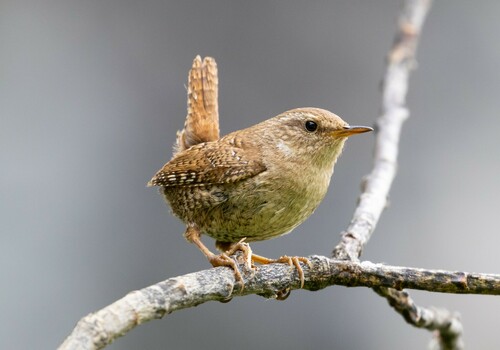
Eurasian Wren
The Eurasian Wren ( *Troglodytes troglodytes*) is a tiny, energetic songbird found across Eurasia and parts of North Africa. Despite its small size, it possesses a remarkably loud and complex song, often surprising those unfamiliar with it. This wren plays a vital role in controlling insect populations within its diverse habitats. In some cultures, the wren is associated with folklore and symbolism, often representing agility, quick wit, and the coming of spring.
8-11 cm
Length
13-17 cm
Wingspan
Least Concern
Conservation Status
Distribution
The Eurasian Wren has a vast range, extending across Europe, Asia (including Japan and the Himalayas), and North Africa. It is largely resident, though northern populations may migrate short distances south in winter. Altitudinally, it can be found from sea level up to the treeline in mountainous regions.
Lifespan
Typically 2-3 years in the wild, although some individuals can live up to 7 years.
Eurasian Wren's Habitat
Habitat Types
Deciduous woodlands, Coniferous forests, Mixed woodlands, Hedgerows, Gardens, Parks, Scrubland, Heathland
Climate Zones
Temperate, Boreal, Mediterranean
Adaptations
Its small size and rounded wings allow it to maneuver through dense undergrowth. Strong legs and feet enable it to cling to branches and creep along crevices in search of food.
Variations
Numerous subspecies (over 20) are recognized, differing slightly in plumage coloration and size. Island populations, such as those in the British Isles and Iceland, often exhibit distinct characteristics.
Appearance
Breeding Plumage
Plumage is generally similar year-round.
Seasonal Feather Changes
Minimal seasonal variation.
Sex Based Plumage Differences
Males and females have very similar plumage.
Notable Features
Small, rounded body shape, Short, often cocked tail, Rich brown upperparts with darker barring, Pale buffish-brown underparts, Prominent pale eyebrow stripe
Diet and Feeding
Primary Foods
Insects, Spiders, Larvae, Beetles, Other small invertebrates
Foraging Behavior
The Eurasian Wren forages actively in dense vegetation, creeping along branches, probing crevices, and searching under leaves and bark for prey. It often flicks its wings and tail while foraging.
Specializations
Its slender bill is well-suited for picking small insects and spiders from tight spaces.
Seasonal Diet Variations
While primarily insectivorous, it may consume some small seeds and berries during winter when insects are scarce.
Behavior
Social Structure
Generally solitary or in pairs, except during breeding season when males may be polygynous.
Communication
Loud, complex song with trills and warbles, Scolding 'churr' calls, Sharp 'tick' calls
Migration
Most populations are resident, but some northern populations undertake short-distance migrations.
Territorial or Group Behaviors
Males are highly territorial during the breeding season, defending their territory with song and aggressive displays.
Conservation
Threats
Habitat loss and fragmentation (though adaptable), Severe winters (can cause significant population declines), Pesticide use (indirectly through food chain)
Protection Programs
General habitat protection measures, Monitoring programs in some regions
Local National Laws
Protected under various national wildlife protection laws across its range.
Population Trend
Stable
Population Estimates
Global population estimated to be 140,000,000-300,000,000 individuals.
Interesting Facts
The Eurasian Wren has one of the loudest songs for its size of any bird.
Its powerful song is used to establish territory and attract mates.
The male wren builds several nests, but only one is chosen by the female.
This behavior may be a way for the female to assess the male's quality.
The scientific name, *Troglodytes troglodytes*, means 'cave dweller'.
This refers to its habit of nesting in crevices and holes.
Faqs about Eurasian Wren
What do I do if I find a baby wren?
If the bird appears healthy and is fully feathered, it is likely a fledgling and its parents are probably nearby. It is best to leave it alone. If it is injured or obviously orphaned, contact a local wildlife rehabilitator. Consult a professional for medical or expert advice.
How can I attract wrens to my garden?
Provide dense, low-growing vegetation, such as shrubs and hedges. Leave leaf litter and avoid using pesticides. A source of fresh water can also be attractive.
Are Eurasian Wrens aggressive?
Males are territorial during the breeding season and will defend their territory against other wrens. However, they are not typically aggressive towards humans.
Copyright @ Nature Style Limited. All Rights Reserved.
 English
English